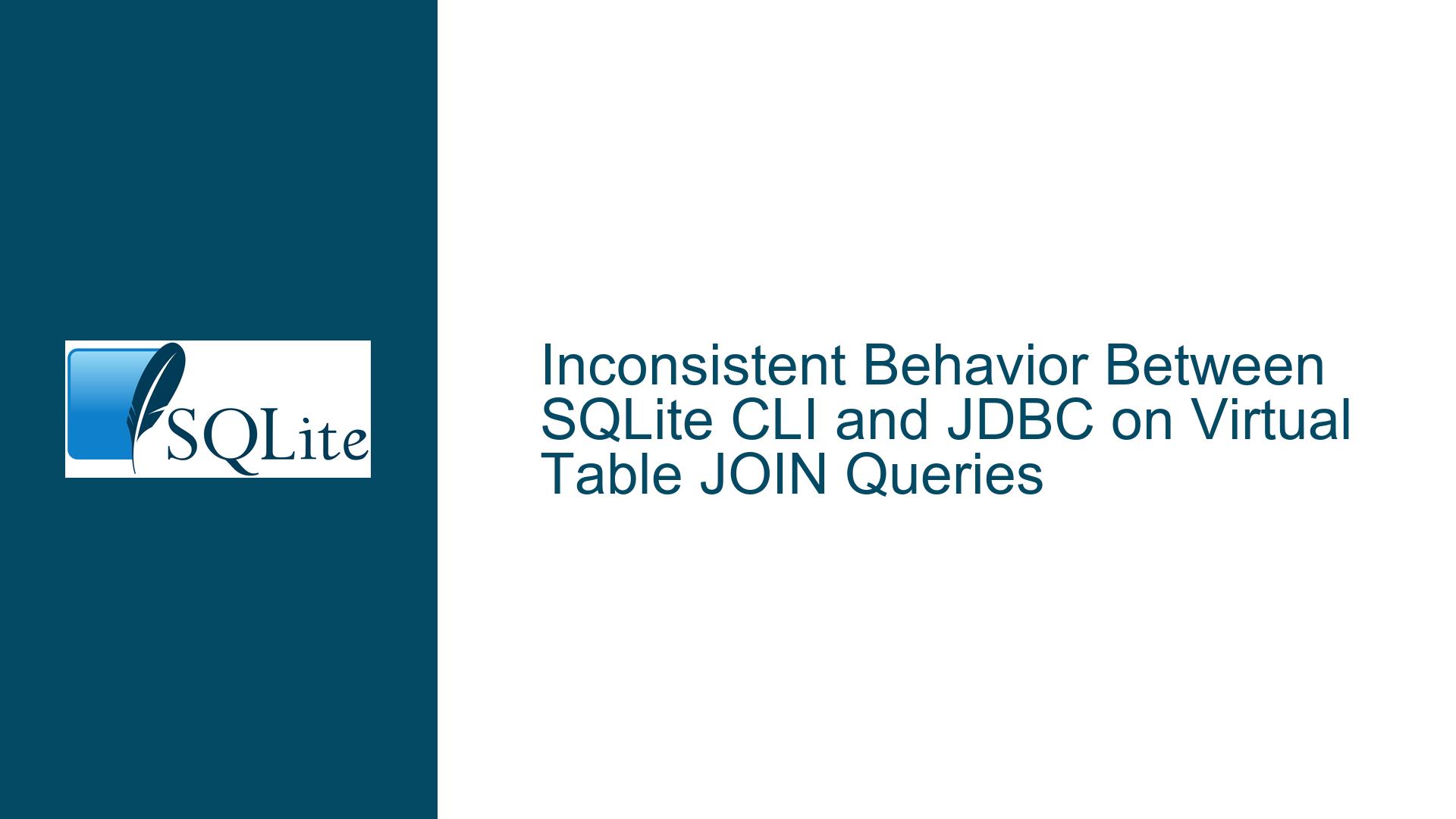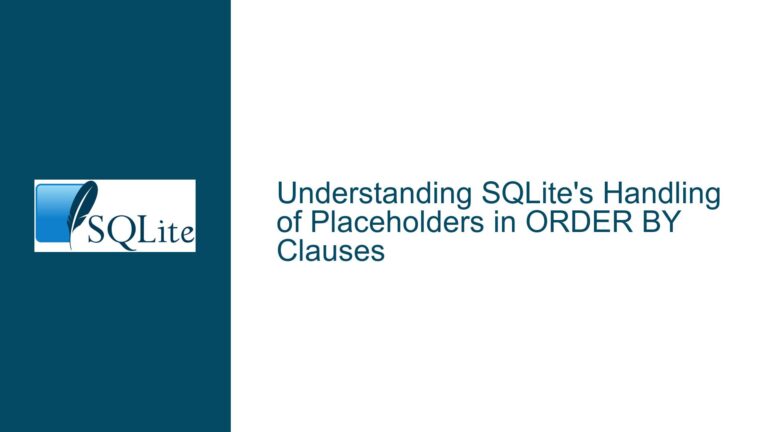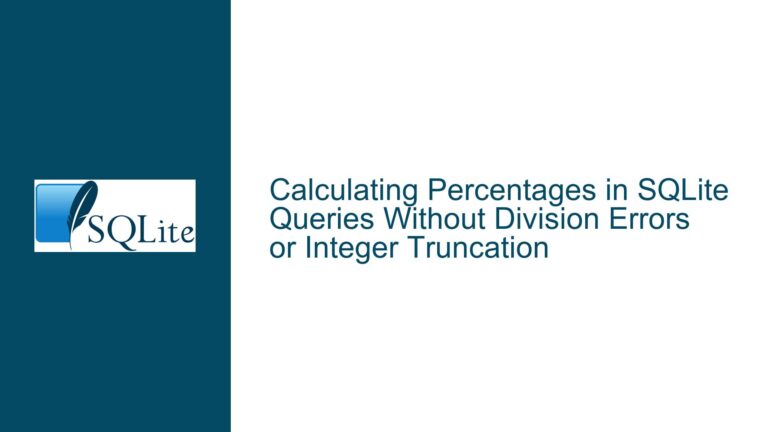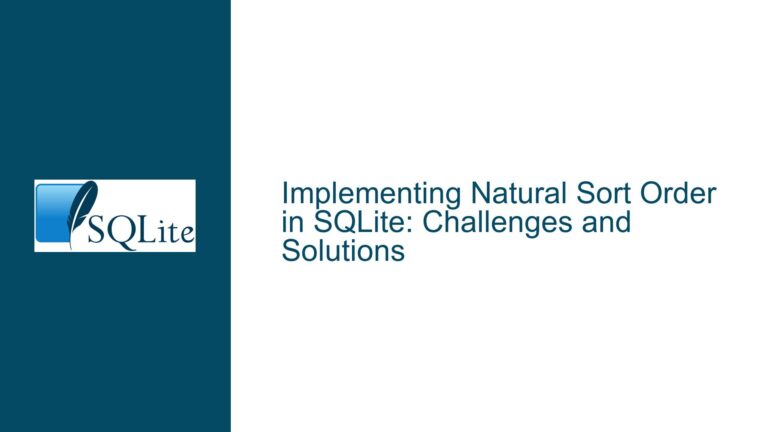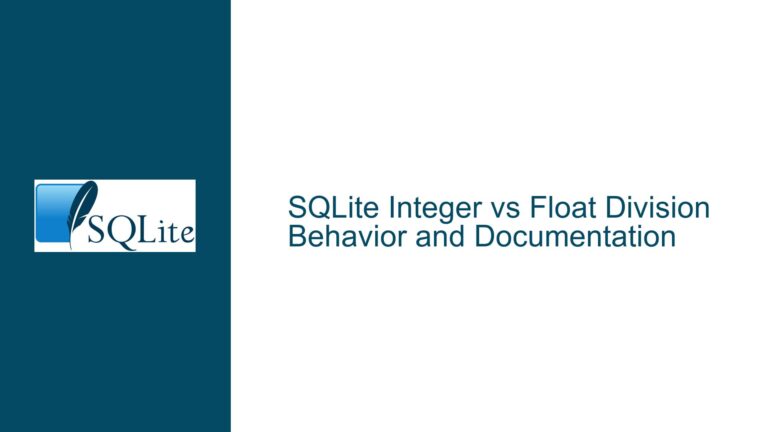Inconsistent Behavior Between SQLite CLI and JDBC on Virtual Table JOIN Queries
Issue Overview: Inconsistent Query Results and Errors Between SQLite CLI and JDBC
The core issue revolves around the inconsistent behavior observed when executing a specific SQL query involving a virtual table (rt1) and a view (v0) in SQLite. The query in question is a FULL OUTER JOIN operation between a virtual table (rt1), a view (v0), and a regular table (vt0). When executed via the SQLite Command-Line Interface (CLI), the query results in an error: unsafe use of virtual table "rt1". However, when the same query is executed using the SQLite JDBC driver, the query does not throw an error but instead returns a NULL result. This discrepancy raises concerns about the reliability and consistency of SQLite’s behavior across different interfaces, particularly when dealing with virtual tables and complex joins.
The virtual table in question, rt1, is created using the rtree_i32 module, which is a spatial indexing module provided by SQLite. The view v0 is defined to select the c0 column from rt1. The regular table vt0 is a simple table with a single column c0. The query attempts to perform a FULL OUTER JOIN between these entities, which is a complex operation that involves combining rows from multiple tables based on a related column between them.
The inconsistency between the CLI and JDBC is particularly problematic because it suggests that the underlying SQLite engine may be handling virtual tables and complex joins differently depending on the interface used. This could lead to unexpected behavior in applications that rely on SQLite for data storage and retrieval, especially when using virtual tables or complex queries.
Possible Causes: SQLITE_DBCONFIG_TRUSTED_SCHEMA and Virtual Table Handling
The primary cause of this inconsistency appears to be related to the SQLITE_DBCONFIG_TRUSTED_SCHEMA configuration option in SQLite. This option determines whether the SQLite engine trusts the schema of the database to be safe from malicious alterations. When SQLITE_DBCONFIG_TRUSTED_SCHEMA is enabled, SQLite assumes that the schema is safe and does not perform certain security checks that would otherwise be performed. This can lead to differences in how queries are executed, particularly when dealing with virtual tables.
In the case of the CLI, SQLITE_DBCONFIG_TRUSTED_SCHEMA is typically disabled by default for security reasons. This means that the CLI performs additional checks to ensure that the schema is safe, which can result in errors when executing queries that involve virtual tables. Specifically, the error unsafe use of virtual table "rt1" is likely triggered because the CLI detects that the virtual table rt1 is being used in a potentially unsafe manner, such as in a complex join operation.
On the other hand, the JDBC driver appears to have SQLITE_DBCONFIG_TRUSTED_SCHEMA enabled by default. This means that the JDBC driver does not perform the same security checks as the CLI, which allows the query to execute without throwing an error. However, because the query involves a complex join with a virtual table, the result is a NULL value, which may not be the expected or desired outcome.
Another possible cause of the inconsistency is the way that the SQLite engine handles virtual tables in different contexts. Virtual tables, such as those created using the rtree_i32 module, are implemented using custom code that may behave differently depending on the context in which they are used. For example, the way that the SQLite engine interacts with a virtual table in a CLI environment may be different from how it interacts with the same virtual table in a JDBC environment. This could lead to differences in how queries are executed and the results that are returned.
Troubleshooting Steps, Solutions & Fixes: Ensuring Consistent Behavior Across Interfaces
To address the inconsistency between the SQLite CLI and JDBC, several steps can be taken to ensure that queries involving virtual tables and complex joins behave consistently across different interfaces. These steps include modifying the SQLITE_DBCONFIG_TRUSTED_SCHEMA setting, adjusting the query to avoid unsafe operations, and ensuring that the virtual table implementation is consistent across different contexts.
Step 1: Modify the SQLITE_DBCONFIG_TRUSTED_SCHEMA Setting
The first step in resolving the inconsistency is to ensure that the SQLITE_DBCONFIG_TRUSTED_SCHEMA setting is consistent across both the CLI and JDBC environments. If the goal is to maintain a high level of security, it is recommended to disable SQLITE_DBCONFIG_TRUSTED_SCHEMA in both environments. This can be done in the CLI by ensuring that the setting is disabled by default, and in the JDBC environment by explicitly disabling the setting in the application code.
To disable SQLITE_DBCONFIG_TRUSTED_SCHEMA in the JDBC environment, the following code can be added to the application:
import org.sqlite.SQLiteConfig;
import java.sql.Connection;
import java.sql.DriverManager;
public class Main {
public static void main(String[] args) {
SQLiteConfig config = new SQLiteConfig();
config.setTrustedSchema(false); // Disable TRUSTED_SCHEMA
try (Connection connection = DriverManager.getConnection("jdbc:sqlite:test.db", config.toProperties())) {
// Execute queries here
} catch (Exception e) {
e.printStackTrace();
}
}
}
By disabling SQLITE_DBCONFIG_TRUSTED_SCHEMA, the JDBC environment will perform the same security checks as the CLI, which should result in consistent behavior when executing queries involving virtual tables.
Step 2: Adjust the Query to Avoid Unsafe Operations
If disabling SQLITE_DBCONFIG_TRUSTED_SCHEMA is not feasible or desirable, the next step is to adjust the query to avoid operations that are considered unsafe when dealing with virtual tables. In the case of the query in question, the FULL OUTER JOIN operation is likely causing the issue because it involves a complex join between a virtual table and other tables.
One possible solution is to rewrite the query to avoid using a FULL OUTER JOIN and instead use a combination of LEFT JOIN and UNION operations to achieve the same result. For example, the following query could be used as an alternative:
SELECT rt1.c0 FROM v0
LEFT JOIN vt0 ON v0.c0 = vt0.c0
UNION
SELECT rt1.c0 FROM rt1
LEFT JOIN vt0 ON rt1.c0 = vt0.c0;
This query performs a LEFT JOIN between v0 and vt0, and then combines the results with a LEFT JOIN between rt1 and vt0 using a UNION operation. This approach avoids the use of a FULL OUTER JOIN and should result in consistent behavior across both the CLI and JDBC environments.
Step 3: Ensure Consistent Virtual Table Implementation
Finally, it is important to ensure that the implementation of the virtual table is consistent across different contexts. This includes ensuring that the custom code used to implement the virtual table behaves consistently regardless of the interface used to interact with it. If the virtual table implementation relies on certain assumptions about the environment in which it is used, these assumptions should be carefully reviewed and adjusted as necessary to ensure consistent behavior.
For example, if the virtual table implementation relies on certain configuration options or environment variables, these should be explicitly set in both the CLI and JDBC environments to ensure that the virtual table behaves consistently. Additionally, any custom code used to implement the virtual table should be thoroughly tested in both environments to identify and address any potential issues.
Conclusion
The inconsistency between the SQLite CLI and JDBC when executing queries involving virtual tables and complex joins is a significant issue that can lead to unexpected behavior in applications. By understanding the underlying causes of this inconsistency, such as the SQLITE_DBCONFIG_TRUSTED_SCHEMA setting and the handling of virtual tables, it is possible to take steps to ensure consistent behavior across different interfaces. This includes modifying the SQLITE_DBCONFIG_TRUSTED_SCHEMA setting, adjusting the query to avoid unsafe operations, and ensuring that the virtual table implementation is consistent across different contexts. By following these steps, developers can ensure that their applications behave reliably and consistently when using SQLite for data storage and retrieval.
